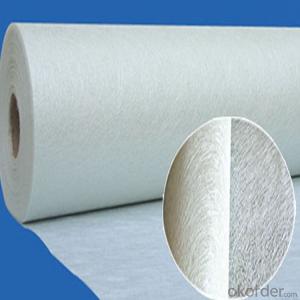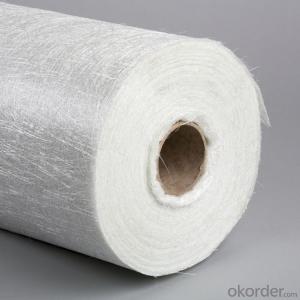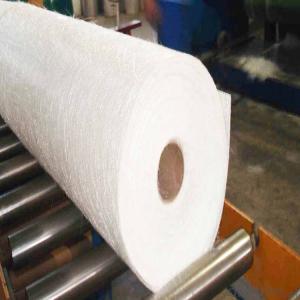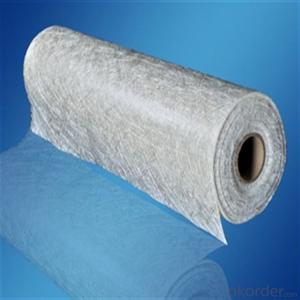450g/m2 Fiberglass Powder Chopped Strand Mat
- Loading Port:
- China main port
- Payment Terms:
- TT OR LC
- Min Order Qty:
- 1 kg
- Supply Capability:
- 5000 kg/month
OKorder Service Pledge
OKorder Financial Service
You Might Also Like
Product Description:
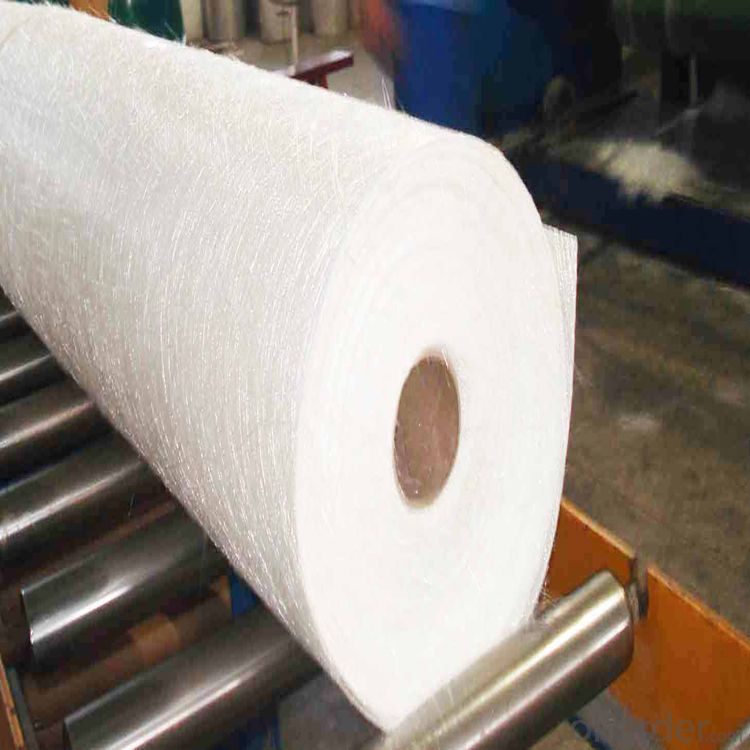
Surfacing Tissue mainly used in the surface layers of FRP products. It features even Fiber distribution, soft feel, level and smooth fiber surface, less glue content, quick resin soak and good pattern fitness. It can improve the product surface property on corrosion resistance, compressive strength, seepage resistance, and longer service life. It is also suitable for spraying; pattern pressing and other FRP pattern technology.
Surfacing Tissue mainly used in the surface layers of FRP products. It features even Fiber distribution, soft feel, level and smooth fiber surface, less glue content, quick resin soak and good pattern fitness. It can improve the product surface property on corrosion resistance, compressive strength, seepage resistance, and longer service life. It is also suitable for spraying; pattern pressing and other FRP pattern technology.
Product Features:
Fast breakdown in styrene
Fiber dispersed evenly
Low binder content
Superior acid corrosion resistance
Specifications:
Item | Over Density | Moisture Content | Chop Density | Polyester Yarn | Width |
(g/m2) | (%) | (g/m2) | (g/m2) | (mm) | |
EMK300 | 309.5 | ≤0.15 | 300 | 9.5 | 50-3300 |
EMK380 | 399 | 380 | 19 | ||
EMK450 | 459.5 | 450 | 9.5 | ||
EMK450 | 469 | 450 | 19 | ||
EMC0020 | 620.9 | 601.9 | 19 | ||
EMC0030 | 909.5 | 900 | 9.5 |
Product Packaging:
Each Surface Tissue is wound onto a paper tube which has an inside diameter of 76mm and the mat roll has a diameter of 330mm. The mat roll is wrapped up with plastic film,and then packed in a cardboard box or wrapped up with kraft paper. The rolls can be vertically or horizontally placed. For transportation, the rolls can be loaded into a cantainer directly or on pallets.
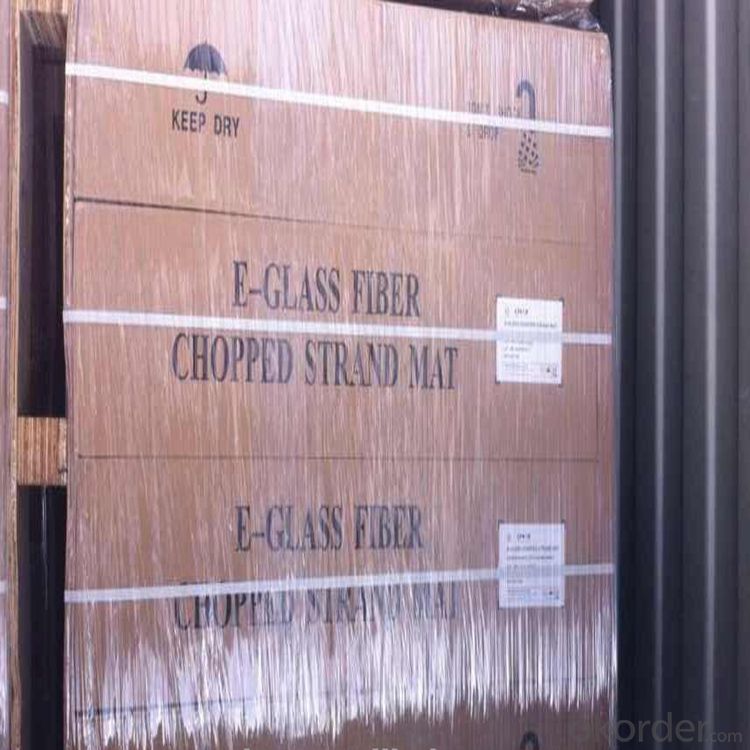
Product Storage:
Unless otherwise specified, Chopped Strand Mat should be stored in a dry, cool and rain-proof area. It is recommended that the room temperature and humidity should be always maintained at 15℃~35℃ and 50%~75% respectively.
Company Information
CNBM (China National Building Material) Group is the largest comprehensive building materials group in China that in integrate scientific research, manufacturing and logistics into one entity. The largest building materials and equipment specialists in China. Upon State Council approval, today CNBM owned more than 300 subordinate manufacturing factories and servicing companies. There are 6 fully owned public listed companies and 11 partially owned with substantial shares public listed companies. In many of these fields, CNBM is playing the leading role in the building industry in the country.

- Q:What types of resins are compatible with fiberglass chopped strand?
- Fiberglass chopped strand can be paired with various resins, each offering unique benefits. Polyester resin, known for its affordability and ease of use, is commonly used and suitable for a wide range of applications. It provides good strength and durability when combined with fiberglass chopped strand. Another compatible resin is epoxy resin, which boasts excellent adhesive properties, high strength, and chemical resistance. It is often chosen for applications requiring a strong bond, such as boat or aircraft construction. For those seeking high-performance and durability, vinyl ester resin is an ideal option. It offers good mechanical properties, chemical resistance, and heat resistance. Specialty resins are also available for use with fiberglass chopped strand. Phenolic resins provide excellent fire resistance, while polyurethane resins offer flexibility and impact resistance. Ultimately, the selection of resin depends on specific project requirements, such as desired strength, chemical resistance, and cost. Seeking guidance from a knowledgeable professional or resin manufacturer is crucial to determine the most suitable resin for your application.
- Q:How does the flame retardancy of the chopped strand affect its performance?
- The performance of the chopped strand is heavily influenced by its flame retardancy. When a chopped strand is flame retardant, it means that it has undergone chemical treatment or coating to prevent or delay the spread of fire. This characteristic is highly desirable in applications where fire safety is a concern. The flame retardant properties of the chopped strand greatly enhance its overall performance. Firstly, it adds an extra layer of protection against fire hazards, reducing the risk of ignition and fire spreading. This is particularly important in industries that deal with flammable materials, such as automotive, aerospace, and construction. By delaying or preventing the spread of fire, the flame retardant chopped strand helps to minimize potential fire damage and loss. Furthermore, the flame retardancy of the chopped strand improves its resistance to heat and thermal degradation. Non-flame retardant materials can quickly deteriorate, lose strength, and emit toxic gases when exposed to high temperatures. In contrast, flame retardant chopped strands can withstand elevated temperatures for a longer time before suffering heat-related damage. This not only ensures the material's structural integrity but also reduces the release of harmful fumes, promoting the safety of individuals near the fire. Additionally, the flame retardant properties of the chopped strand can contribute to increased product longevity. By reducing the risk of fire-related accidents and damage, it helps prolong the material's lifespan, enhancing its durability and performance over time. This is particularly crucial in applications where the material is exposed to potential fire hazards or where failure due to fire could have severe consequences. In conclusion, the flame retardancy of the chopped strand is a critical factor in determining its performance. It provides improved fire safety, resistance to heat and thermal degradation, and contributes to the material's overall durability and longevity. Therefore, opting for flame retardant chopped strands can significantly enhance the performance and reliability of various products and applications.
- Q:Can fiberglass chopped strand be used in the production of bathroom fixtures?
- The production of bathroom fixtures can benefit from the use of fiberglass chopped strand. This reinforcing material is typically comprised of fine glass fibers that have been chopped into shorter lengths. It is commonly employed as a reinforcement in a variety of materials and products, including bathroom fixtures. Bathroom fixtures, such as bathtubs, shower trays, sinks, and toilet tanks, necessitate a resilient and robust material that can endure water, moisture, and regular usage. Fiberglass chopped strand is an excellent choice for fortifying these fixtures due to its impressive strength-to-weight ratio, resistance to corrosion, and ability to withstand water. To create a composite material for the production of bathroom fixtures, fiberglass chopped strand is usually combined with a resin matrix, such as polyester or acrylic. This composite material offers the necessary strength and durability required to withstand the demands of daily use in a bathroom setting. Furthermore, fiberglass chopped strand can be effortlessly molded into various shapes and sizes, allowing for the creation of customized and visually appealing bathroom fixtures. It can also be easily blended with other materials, such as gelcoats or colorants, to achieve desired surface finishes or colors. Overall, fiberglass chopped strand is a suitable and extensively utilized material in the production of bathroom fixtures due to its strength, durability, resistance to water, and versatility in design.
- Q:How does the density of the chopped strand affect its performance?
- The density of the chopped strand can greatly impact its performance. A higher density usually results in better mechanical properties such as strength and stiffness. It also enhances the strand's ability to resist impact and fatigue. On the other hand, a lower density may offer improved flexibility and better resin penetration. Ultimately, the suitable density depends on the specific application and desired performance characteristics.
- Q:Is fiberglass chopped strand lightweight?
- Yes, fiberglass chopped strand is lightweight. Chopped strand refers to short fibers of fiberglass that have been cut to a specific length. These fibers are typically mixed with a resin or binder to form a composite material. Since fiberglass itself is a lightweight material, the chopped strands retain this characteristic. This makes fiberglass chopped strand an ideal choice for applications that require a lightweight material, such as automotive parts, boat hulls, and aerospace components. Additionally, the lightweight nature of fiberglass chopped strand allows for increased flexibility and ease of handling during the manufacturing process.
- Q:Can fiberglass chopped strand be used in the manufacturing of electrical enclosures?
- Yes, fiberglass chopped strand can be used in the manufacturing of electrical enclosures. Fiberglass chopped strand is a reinforcing material that is made up of glass fibers that have been chopped into small pieces. It is commonly used in various industries, including electrical engineering, due to its excellent electrical insulation properties. When used in the manufacturing of electrical enclosures, fiberglass chopped strand can provide added strength and durability to the enclosures. It helps enhance the mechanical properties of the enclosure, making it resistant to impact, corrosion, and other external factors. Additionally, fiberglass chopped strand is non-conductive, which is crucial in electrical applications as it helps prevent any electrical shorts or hazards. Furthermore, fiberglass chopped strand can be easily molded or formed into complex shapes, making it suitable for manufacturing enclosures with intricate designs or specific requirements. It can also be combined with other materials, such as resins or polymers, to create composite materials that offer improved performance and versatility. Overall, the use of fiberglass chopped strand in the manufacturing of electrical enclosures offers numerous benefits, including enhanced strength, durability, electrical insulation, and flexibility in design.
- Q:Can fiberglass chopped strand be used in insulation applications?
- Yes, fiberglass chopped strand can be used in insulation applications. Fiberglass chopped strand is a common material used in insulation due to its excellent thermal resistance properties. It effectively traps air pockets within its structure, which helps to reduce heat transfer and maintain a stable temperature in the insulated space. Additionally, fiberglass chopped strand insulation is lightweight, durable, and resistant to moisture, making it suitable for a wide range of insulation applications. Whether it is used in residential buildings, commercial establishments, or industrial facilities, fiberglass chopped strand insulation provides an effective solution for thermal insulation requirements.
- Q:Can fiberglass chopped strand be used in the production of medical prosthetics?
- Fiberglass chopped strand is indeed applicable for the manufacturing of medical prosthetics. It serves as a reinforcing substance typically produced from delicate glass fibers and is commonly employed in composite materials. When producing medical prosthetics, fiberglass chopped strand can be integrated into the composite structure of the prosthetic limb or device to furnish additional strength and durability. This reinforcement bolsters the structural integrity of the prosthetic, granting it improved resistance against stress and wear. Moreover, fiberglass chopped strand can be effortlessly molded and shaped to meet the specific design prerequisites of the prosthetic, enabling greater customization and comfort for the patient. Nevertheless, it is crucial to bear in mind that the utilization of fiberglass chopped strand in medical prosthetics must adhere to relevant regulations and standards to guarantee the safety and efficacy of the final product.
- Q:What are the advantages of using fiberglass chopped strand in construction?
- Construction can benefit in several ways from the use of fiberglass chopped strand. To begin with, fiberglass chopped strand is renowned for its impressive strength-to-weight ratio. This means that it possesses great durability and resilience while remaining lightweight, making it an ideal material for construction purposes. Its strength enables it to withstand heavy loads and stress, rendering it suitable for a wide range of structural components. Furthermore, fiberglass chopped strand exhibits exceptional resistance to corrosion. It does not rust or corrode like metals, ensuring that it remains a long-lasting material capable of withstanding harsh environmental conditions. This is particularly advantageous in construction, where exposure to moisture, chemicals, and other corrosive elements is commonplace. Additionally, fiberglass chopped strand is an incredibly versatile material that can be effortlessly molded into various shapes and sizes. It can be utilized to create intricate architectural designs and innovative structures. Its flexibility allows for customized fabrication, making it suitable for construction projects with unique requirements. Moreover, fiberglass chopped strand functions as an excellent insulator. It possesses low thermal conductivity, meaning that it does not easily transfer heat. Consequently, it proves to be an effective material for insulation purposes, maintaining cool temperatures in hot climates and reducing energy consumption for heating and cooling needs. Furthermore, fiberglass chopped strand exhibits fire resistance. It boasts a high melting point and does not ignite easily. In the event of a fire, it can help contain the spread of flames and minimize damage to the structure. Lastly, fiberglass chopped strand proves to be cost-effective. Although it may initially have a higher upfront cost compared to traditional materials, its durability, low maintenance requirements, and long lifespan make it a financially prudent choice in the long term. It diminishes the need for frequent repairs and replacements, ultimately saving both time and money. To summarize, the advantages of incorporating fiberglass chopped strand into construction projects encompass its remarkable strength-to-weight ratio, corrosion resistance, versatility, insulation properties, fire resistance, and cost-effectiveness. These attributes make it an appealing option for a diverse array of construction applications.
- Q:How does the tensile strength of the chopped strand affect its performance?
- The tensile strength of a chopped strand directly affects its performance in various applications. Tensile strength is a measure of the maximum amount of tensile stress a material can withstand before breaking or fracturing. In the context of chopped strands, which are short, discrete fibers, the tensile strength determines their ability to resist pulling or stretching forces. A higher tensile strength in chopped strands generally leads to improved performance in several ways. Firstly, it enhances the overall strength and structural integrity of composite materials when these chopped strands are incorporated into them. Composite materials, such as fiberglass composites, rely on the reinforcement provided by chopped strands to improve their mechanical properties, including tensile strength. Higher tensile strength chopped strands allow for greater load-bearing capacity and resistance to deformation or failure. Secondly, a higher tensile strength in chopped strands enhances their ability to withstand external forces and extreme environmental conditions. This is particularly important in applications where the chopped strands are exposed to constant stress, such as in automotive parts, aerospace components, or infrastructure materials. The higher tensile strength allows for increased durability and longevity, reducing the likelihood of premature failure or damage. Moreover, the tensile strength of chopped strands also affects their processability and handling characteristics. Higher tensile strength chopped strands are less prone to breakage or fiber pull-out during handling, cutting, mixing, or molding processes. This improves the overall efficiency and quality of manufacturing operations, reducing waste and ensuring consistent performance in the final product. In summary, the tensile strength of chopped strands plays a crucial role in their performance. Higher tensile strength chopped strands offer improved strength, durability, and processability, making them more suitable for demanding applications where structural integrity and long-term performance are essential.
1. Manufacturer Overview |
|
|---|---|
| Location | |
| Year Established | |
| Annual Output Value | |
| Main Markets | |
| Company Certifications | |
2. Manufacturer Certificates |
|
|---|---|
| a) Certification Name | |
| Range | |
| Reference | |
| Validity Period | |
3. Manufacturer Capability |
|
|---|---|
| a)Trade Capacity | |
| Nearest Port | |
| Export Percentage | |
| No.of Employees in Trade Department | |
| Language Spoken: | |
| b)Factory Information | |
| Factory Size: | |
| No. of Production Lines | |
| Contract Manufacturing | |
| Product Price Range | |
Send your message to us
450g/m2 Fiberglass Powder Chopped Strand Mat
- Loading Port:
- China main port
- Payment Terms:
- TT OR LC
- Min Order Qty:
- 1 kg
- Supply Capability:
- 5000 kg/month
OKorder Service Pledge
OKorder Financial Service
Similar products
New products
Hot products
Related keywords

